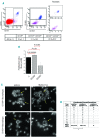Dexamethasone targeted directly to macrophages induces macrophage niches that promote erythroid expansion
- PMID: 25533803
- PMCID: PMC4803138
- DOI: 10.3324/haematol.2014.114405
Dexamethasone targeted directly to macrophages induces macrophage niches that promote erythroid expansion
Abstract
Cultures of human CD34(pos) cells stimulated with erythroid growth factors plus dexamethasone, a model for stress erythropoiesis, generate numerous erythroid cells plus a few macrophages (approx. 3%; 3:1 positive and negative for CD169). Interactions occurring between erythroblasts and macrophages in these cultures and the biological effects associated with these interactions were documented by live phase-contrast videomicroscopy. Macrophages expressed high motility interacting with hundreds/thousands of erythroblasts per hour. CD169(pos) macrophages established multiple rapid 'loose' interactions with proerythroblasts leading to formation of transient erythroblastic island-like structures. By contrast, CD169(neg) macrophages established 'tight' interactions with mature erythroblasts and phagocytosed these cells. 'Loose' interactions of CD169(pos) macrophages were associated with proerythroblast cytokinesis (the M phase of the cell cycle) suggesting that these interactions may promote proerythroblast duplication. This hypothesis was tested by experiments that showed that as few as 103 macrophages significantly increased levels of 3-(4,5-dimethylthiazolyl-2)-2,5-diphenyltetrazolium bromide incorporation frequency in S/G2/M and cytokinesis expressed by proerythroblasts over 24 h of culture. These effects were observed also when macrophages were co-cultured with dexamethasone directly conjugated to a macrophage-specific CD163 antibody. In conclusion, in addition to promoting proerythroblast proliferation directly, dexamethasone stimulates expansion of these cells indirectly by stimulating maturation and cytokinesis supporting activity of macrophages.
Copyright© Ferrata Storti Foundation.
Figures






References
-
- Gursoy A, Dogruk Unal A, et al. Polycythemia as the first manifestation of Cushing’s disease. J Endocrinol Invest. 2006;29(8):742–744. - PubMed
-
- Migliaccio G, Masiello F, Tirelli V, et al. Under HEMA conditions, self-replication of human erythroblasts is limited by autophagic death. Blood Cells Mol Dis. 2011;47(3):182–197. - PubMed
Publication types
MeSH terms
Substances
Grants and funding
LinkOut - more resources
Full Text Sources
Other Literature Sources
Research Materials

